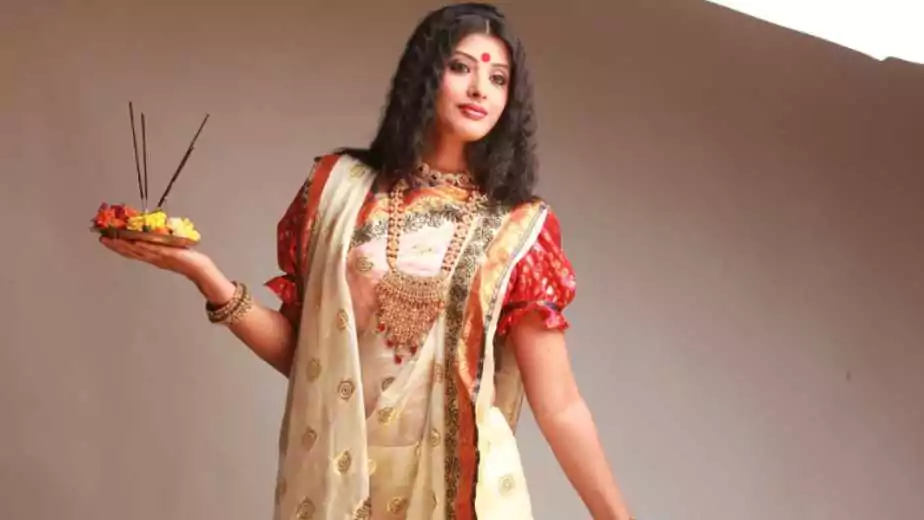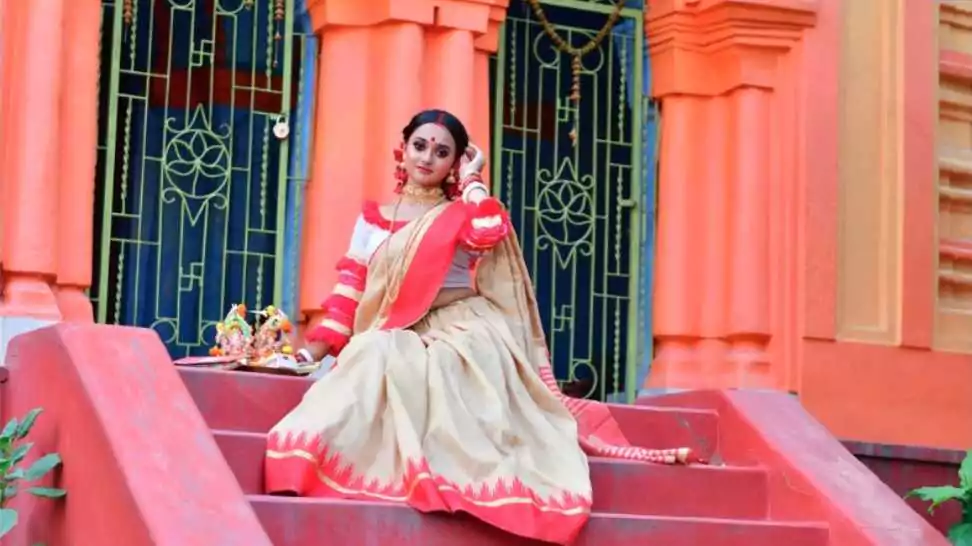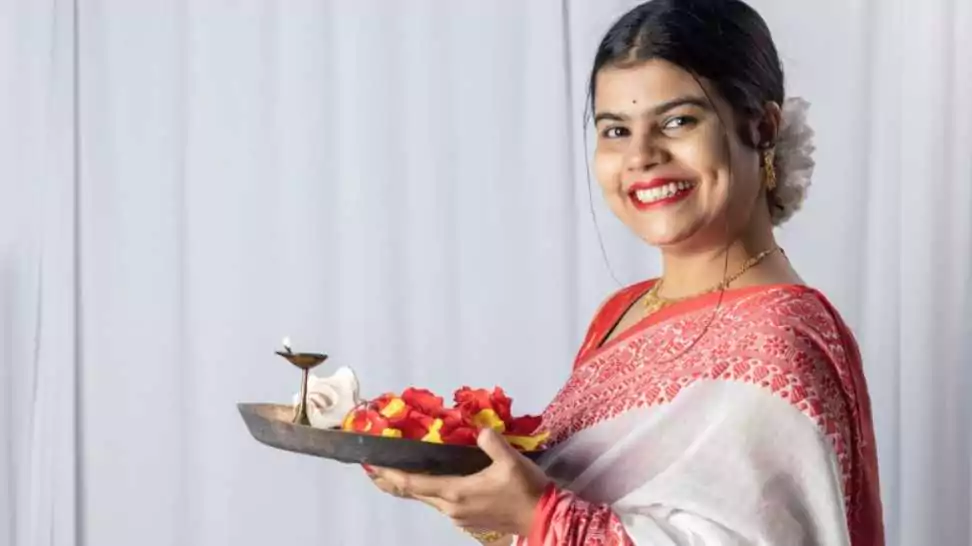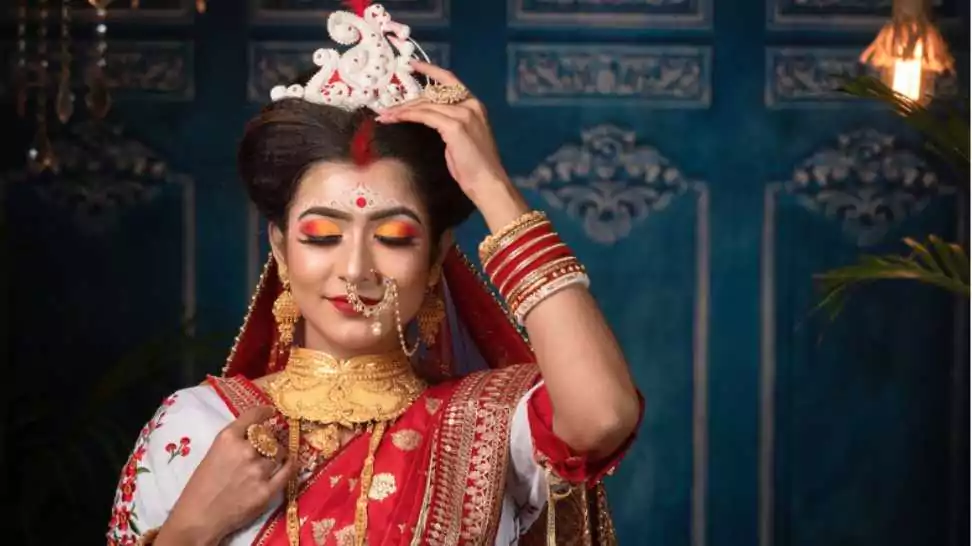How To Wear Bengali Saree For Every Occasion?

The Bengali saree stands as a testament to Bengal’s rich cultural heritage, seamlessly blending centuries-old traditions with contemporary fashion. Crafted by artisans using materials like cotton and silk, these sarees are distinguished by their unique drape and vibrant designs, which reflect Bengal’s socio-cultural evolution. Unlike the pleated Nivi style common across India, the traditional Bengali saree features a pleatless front, with the pallu elegantly secured over the shoulder, often with a key ring for added sophistication.
With a variety of fabrics suited for different occasions, the choice of a Bengali saree can significantly influence one’s look. Cotton sarees such as the Tant and Dhakai Jamdani offer comfort for daily wear, while silk variants like Baluchari and Korial, adorned with intricate designs and motifs, cater to formal events and celebrations. This guide will explore the intricacies of how to wear Bengali saree, accessorizing tips, and maintenance advice, aiming to provide the knowledge needed to wear this traditional attire with confidence and grace.
1 Preparing to Drape Your Bengali Saree
Draping a Bengali saree to perfection requires a bit of preparation. The elegance of the saree is in the details, and ensuring you have all the essential items on hand before you start is crucial. Here’s what you need and some preliminary steps to follow to make sure your saree draping experience is smooth and successful.
Essential Items Needed
- Petticoat: An underskirt tied tightly at the waist by a drawstring. It should be of a colour matching your saree to prevent it from showing through. The petticoat helps hold the saree in place and gives it a neat drape.
- Blouse: The blouse or choli should complement your saree. It can either be a perfect match or a striking contrast, depending on the look you’re going for. Ensure it fits well for a polished look.
- Safety Pins: These are lifesavers when draping a saree. Have a handful of safety pins ready to secure the saree at different points. They help manage the pallu, pleats, and any extra fabric, ensuring everything stays in place.
- Saree Pins: Slightly different from regular safety pins, saree pins are often decorative and help in pinning the pallu over the shoulder in a way that adds to the saree’s aesthetic without damaging the fabric.
- Iron and Ironing Board: A well-ironed saree is easier to handle and drapes better. Removing all creases and folds beforehand will give your saree a crisp, elegant look.
Preliminary Steps Before Draping
- Ironing: Begin by carefully ironing your saree to remove any wrinkles. Use the appropriate heat setting for the fabric to avoid damage. For silk sarees, it’s often recommended to use a slightly damp cloth between the saree and the iron to protect the delicate fabric.
- Folding: Once ironed, fold the saree lightly without pressing hard on the folds to avoid creating new creases. This makes it easier to handle and drape.
- Laying Out the Saree: Lay the saree out on a clean, flat surface to identify the end you will start draping from. The end with the more elaborate pallu should be set aside to be draped over the shoulder later.
- Wearing the Petticoat and Blouse: Put on the petticoat and tie it securely at the waist, ensuring it is tight enough to support the saree but comfortable.
Wear your blouse, making sure it fits well and complements your saree.

2 Draping Your Bengali Saree

Now that you have prepared all the essentials and are ready to drape your saree, let’s walk through the process step by step. Draping a Bengali saree is an art, and with practice, you can master this elegant style.
Step 1: Wearing the Petticoat and Blouse
Ensure you are wearing the petticoat and blouse. The petticoat should be tied securely at the waist, and the blouse should fit well, complementing your saree.
Step 2: Beginning the Drape
Start by tucking the plain end of the saree into the petticoat at your right hip, slightly to the back. Wrap the saree around your waist a full circle, and bring it back to the front. Ensure the lower end of the saree is at an even length all around, just touching the floor.
Step 3: Making the First Pleats
Make about 5-6 pleats from the fabric that comes to the front. These pleats are approximately 5 inches wide each. Tuck these pleats into the petticoat at the front, slightly to the left of the navel, ensuring they open to your left. The pleats add grace to your movement and should fall straight and even.
Step 4: Bringing the Pallu Over
Take the other end of the saree, which is the more decorated pallu end, and drape it over your left shoulder. The pallu should fall behind you, ideally reaching your knees. Bengali sarees often feature beautiful work on the pallu, which should be displayed prominently.
Step 5: The Second Wrap
Now, take the portion of the saree that hangs behind you from the left shoulder, bring it under your right arm, and then over your left shoulder again. This double wrap is characteristic of the Bengali saree style, giving it a unique appearance.
Step 6: Securing the Pallu
After adjusting the pallu to ensure it drapes elegantly, secure it in place at the shoulder with a safety pin. You can also use a decorative saree pin for added style.
Step 7: Final Adjustments
Make any necessary adjustments to the pleats at the front and the pallu to ensure they sit neatly and comfortably. The saree should drape smoothly over your body without any tight pulls or loose fabric.
Tips for Draping
- Practise the pleating and draping in front of a mirror to get a better sense of how the saree falls and adjusts on your body.
- Do not rush the process. Take your time to ensure each step is done neatly for the best overall effect.
- Use safety pins judiciously to secure the saree, but try not to pin through heavily embroidered or delicate fabrics directly.
3 How to Wear Bengali Saree for Wedding

Wearing a Bengali saree for a wedding demands a blend of tradition, elegance, and personal style. Whether you are the bride, a part of the bridal party, or a guest, knowing how to drape your saree for a wedding can elevate your look. Here, we provide detailed instructions and tips to help you wear a Bengali saree for wedding occasions with grace and sophistication.
Step-by-Step Instructions
Step 1: Selecting the Saree
Choose a saree that is befitting the grandeur of a wedding. Silk sarees such as Baluchari, Banarasi, or heavily embroidered Tant sarees are excellent choices. Look for vibrant colours and intricate designs that stand out.
Step 2: Draping the Saree
- Start with the Petticoat and Blouse: Ensure that your petticoat is tied snugly at the waist and that your blouse complements your saree beautifully.
- Tuck and Wrap: Begin by tucking the saree into the petticoat on the right side, and wrap it around your waist once, ensuring the lower end of the saree touches the ground evenly.
- Pleating: Create broad, even pleats with the section of the saree that comes around to the front. Tuck these pleats into the petticoat, slightly off-centre to the left of the navel, ensuring they open towards the left.
- Pallu Setting: Drape the pallu over your left shoulder, allowing it to fall gracefully. The pallu should be pleated neatly if you prefer a more structured look.
- Double Drape: For a traditional Bengali wedding look, bring the pallu end from the back over your right shoulder, then under the right arm, and finally over the left shoulder again. This creates a double-layered look that is both elegant and traditional.
Step 3: Securing the Saree
Use safety pins to secure the pleats at the waist and the pallu over the shoulder. Ensure the pins are hidden and do not damage the fabric.
Tips for Choosing the Right Saree and Accessories
Choosing the Saree:
- Opt for silk sarees with gold or silver zari work for a luxurious look.
- Consider the time of the event; lighter colours for daytime and richer, deeper hues for evening celebrations.
- The saree should complement your body type and skin tone.
Accessories:
- Jewellery: Traditional gold or diamond jewellery enhances the elegance of Bengali sarees. Consider wearing a matching set of earrings, necklaces, bangles, and rings. A maang tikka or a jhumar can add a royal touch.
- Footwear: Choose comfortable yet stylish heels that complement your saree and your height. The saree should just graze the ground, so adjust your petticoat accordingly.
- Bags: A small clutch or potli bag that matches your saree or jewellery can hold essentials without detracting from your look.
- Hair and Makeup: Opt for a traditional bun or braid adorned with flowers. Makeup should be elegant, highlighting your features and complementing the colours of your saree.
Draping the Bengali Saree With Pleats

Incorporating pleats into the Bengali saree drape adds a touch of grace and sophistication, perfect for those seeking a blend of traditional elegance and modern flair. Pleats can make the saree more manageable and add structure to your look. This detailed guide will walk you through the process of adding pleats to your Bengali saree drape, ensuring a polished and graceful appearance.
Step-by-Step Guide to Adding Pleats
Step 1: Start With the Basic Wrap
- Begin by wearing your petticoat and blouse. Ensure the petticoat is tied securely at your waist.
- Tuck the non-pallu end of the saree into the petticoat on your right side, wrap it around your waist once, and bring it back to the front.
Step 2: Creating Front Pleats
- Now, create a broad, even pleats with the portion of the saree that’s in front of you. These pleats will be tucked into the waist, slightly to the left of the navel. The number of pleats can vary, but usually, 5 to 7 pleats of about 5 inches each work well for a full, graceful look.
- Hold the pleats together tightly and adjust them so they are even at the bottom. Tuck the pleats into your petticoat, ensuring they face the left side for the traditional Bengali look.
Step 3: Draping the Pallu With Pleats
- Take the pallu end of the saree and make neat, even pleats here as well. The width of these pleats can be narrower than the front pleats to allow for a neat drape over the shoulder.
- Drape the pleated pallu over your left shoulder, letting it fall to your desired length. The traditional Bengali style often features a longer pallu, extending to the back of the knees.
- Secure the pleated pallu with a pin on your shoulder to keep it in place.
Step 4: Adjusting the Pleats
- Adjust the front pleats so they sit neatly and comfortably at your waist. They should fan out nicely to allow ease of movement.
- Ensure the pallu pleats are also lying flat and elegantly over your shoulder. Use a decorative pin for an added touch of style if you wish.
Step 5: Final Touches
- Check the overall drape in a full-length mirror, making adjustments as necessary to ensure the saree falls beautifully and evenly.
- The saree should cover your petticoat completely, with both the front pleats and the pallu pleats arranged neatly for a polished look.
4 Embracing Tradition: Wearing the Bengali Saree the Traditional Way
The traditional Bengali saree is not just an attire; it’s a symbol of cultural heritage, elegance, and identity. Draped in a manner that has been passed down through generations, it embodies the essence of Bengali festivities and cultural events. This section provides instructions on how to wear the traditional Bengali saree and highlights the significance of its draping styles, ensuring you carry forward a legacy with every fold and tuck.
Instructions on Draping the Traditional Bengali Saree
Step 1: Preparation
- Begin by choosing a saree appropriate for the occasion. Handloom sarees like Tant, Jamdani, or Baluchari are perfect for their traditional appeal and intricate craftsmanship.
- Wear a well-fitted petticoat and blouse that complements your saree. The petticoat should be tied firmly around the waist.
Step 2: Basic Wrap
- Start by tucking the non-pallu end of the saree into the petticoat at the right waist, slightly towards the back, and wrap it around your body once. The saree should touch the ground slightly, ensuring graceful movement.
Step 3: Creating the Pleats
- Create about 4-5 pleats from the fabric that comes to the front. These pleats are slightly broader than the pleats in a Nivi-style drape and should be tucked in the front, to the right of the navel. The pleats symbolize the traditional Bengali drape, adding elegance and structure to the saree.
Step 4: Draping the Pallu
- Bring the pallu over your left shoulder, allowing it to fall gracefully behind you. The traditional Bengali saree drape often involves the pallu being draped in a unique way, with the end of the pallu brought under the right arm and then thrown back over the left shoulder, creating a double-layered effect.
Step 5: Final Adjustments
- Secure the pallu on your shoulder with a pin. Adjust the pleats on your shoulder and at the waist, ensuring they are even and fall neatly. The front pleats should be displayed prominently, showcasing the beauty of the saree and its craftsmanship.
Significance of Traditional Draping Styles
The traditional Bengali saree draping style is a testament to Bengal’s rich cultural history. Each element of the drape, from the broad front pleats to the elegantly draped pallu, tells a story of social evolution, artistic expression, and the integral role of women in Bengali culture.
- Broad Front Pleats: These symbolize the grace and dignity of Bengali women. They add a formal and structured look to the saree, making it suitable for various cultural events and festivities.
- Pallu Draped Over the Shoulder: This style is not only practical, allowing freedom of movement, but it also showcases the intricate designs of the saree, often depicting stories from mythology, folklore, or the rich tapestry of Bengali life.
- Double-layered Pallu: Unique to the Bengali saree, this draping method adds volume and a distinctive style to the saree, setting it apart from other regional drapes.
5 How to Wear Bengali Saree for Dance Performances
Dancing in a Bengali saree is a beautiful way to showcase cultural heritage through movement and grace. However, wearing a saree for dance requires careful selection of fabric and a secure draping method to ensure both beauty and mobility are maintained throughout the performance. This section offers tailored guidance on how to wear a Bengali saree for dance performances, ensuring you look stunning while moving freely.

Selecting the Right Fabric
- Choose Lightweight Fabrics: For dance performances, opt for lightweight sarees such as fine cotton, georgette, or light silk. These materials offer fluidity and are easier to manage during movements.
- Consider the Saree’s Work: Embroideries and embellishments add beauty but can restrict movement if too heavy. Select sarees with minimalistic designs or those where the work is concentrated on the pallu and borders, keeping the body of the saree light.
Securing the Saree for Performance
Step 1: Wearing the Petticoat and Blouse
- Ensure the petticoat is tightly secured but comfortable, offering a firm base for the saree. The blouse should offer freedom of movement, especially around the arms and shoulders.
Step 2: Tucking and Wrapping
- Start by tucking the saree end into the petticoat from the right side, taking a complete turn around the body. The saree’s length should be slightly above the ground to prevent tripping, considering the footwork involved in dance.
Step 3: Forming Pleats
- Instead of making broad pleats at the front, opt for narrower and more pleats to ensure a snug fit that holds through vigorous movements. Tuck these pleats in the centre, slightly to the left of the navel, ensuring they are secure.
Step 4: Draping the Pallu
- For dance, the pallu can be pleated neatly and pinned securely on the left shoulder to avoid it falling off during the performance. Alternatively, wrap the pallu around the waist and tuck it in firmly on the left side, creating a streamlined look that enhances mobility.
Step 5: Additional Securing
- Use safety pins judiciously to secure the saree at key points: the pleats at the waist, the pallu on the shoulder, and any other areas prone to movement. Body-adhesive tapes can also be used discreetly to keep the saree in place against the blouse and petticoat.
Enhancing Mobility
- Pleat the Saree Higher: For greater leg movement, consider tucking the saree slightly higher than normal, ensuring it stays clear of the feet during dance steps.
- Secure Loose Ends: Any loose ends of the saree or pallu should be pinned back or tucked in to prevent them from interfering with the dance performance.
- Practice in Costume: Before the performance, rehearse in your saree to get accustomed to its flow, weight, and how it moves with you. This practice can help adjust the saree’s drape for optimum comfort and elegance.
6 Mastering the Perfect Drape
Achieving the perfect drape in a Bengali saree involves more than just following steps; it’s about understanding the nuances that contribute to a polished, elegant look. This section delves into techniques to wear a Bengali saree perfectly and highlights common mistakes to avoid during the draping process, ensuring you look impeccably graceful at any event.
Techniques for the Perfect Drape
- Fabric Alignment: Before you begin draping, ensure the saree’s fabric is evenly aligned with the ground. The saree’s lower hem should skim the floor all around, creating a uniform and elegant baseline.
- Pleat Precision: Pleats are the heart of the saree’s elegance. Spend time making sure they are evenly spaced and neatly folded. For the Bengali drape, the front pleats should be broad and evenly placed, while the pallu pleats can be narrower. Use your fingers to crease the pleats sharply for a crisp look.
- Pallu Length and Placement: The pallu’s length and how it is placed can dramatically affect the saree’s overall appearance. In traditional Bengali style, the pallu should fall gracefully over the shoulder, with the end reaching the back of the knees. Ensure it’s not too short or too long, disrupting the balance of the drape.
- Secure Tucking: Securely tuck the saree at the waist, ensuring it’s tight enough to stay in place but not so tight that it becomes uncomfortable or alters the saree’s flow. A well-tucked saree defines the waistline and enhances the saree’s grace.
- Balance Between Tightness and Comfort: While it’s important for the saree to be securely draped, avoid wrapping it too tightly around the body. This can restrict movement and may lead to a dishevelled look over time. Aim for a snug, comfortable fit that allows for freedom of movement.
Common Mistakes to Avoid
- Ignoring the Saree’s Length: One of the most common mistakes is not adjusting the saree’s length properly. A saree that’s too long can cause tripping, while one that’s too short can look ungraceful.
- Uneven Pleats: Rushing through pleating or not securing them properly can lead to uneven, messy pleats that detract from the saree’s elegance.
- Overusing Pins: While safety pins are essential for securing the saree, using too many can make the drape rigid and can damage the fabric. Use them sparingly and strategically.
- Neglecting the Blouse and Petticoat: The fit of the blouse and petticoat can significantly affect the saree’s drape. An ill-fitting blouse or a loosely tied petticoat can ruin the overall look.
- Forgetting to Adjust After Draping: Once you’ve finished draping the saree, take a few moments to adjust the pleats, pallu, and overall fit. Small adjustments can make a big difference in achieving a polished appearance.
7 Wrapping Up
Mastering the art of wearing a Bengali saree is a journey into the heart of Bengali culture, tradition, and elegance. Throughout this guide, we’ve explored the nuances of draping a Bengali saree, from the basics of selecting the right fabric and preparing for the drape, to the intricacies of traditional and contemporary styles. The Bengali saree is not just a piece of clothing; it’s a symbol of grace, heritage, and the enduring beauty of Indian textiles.
Community Q&A
About This Article
This article has been viewed 94 times.



